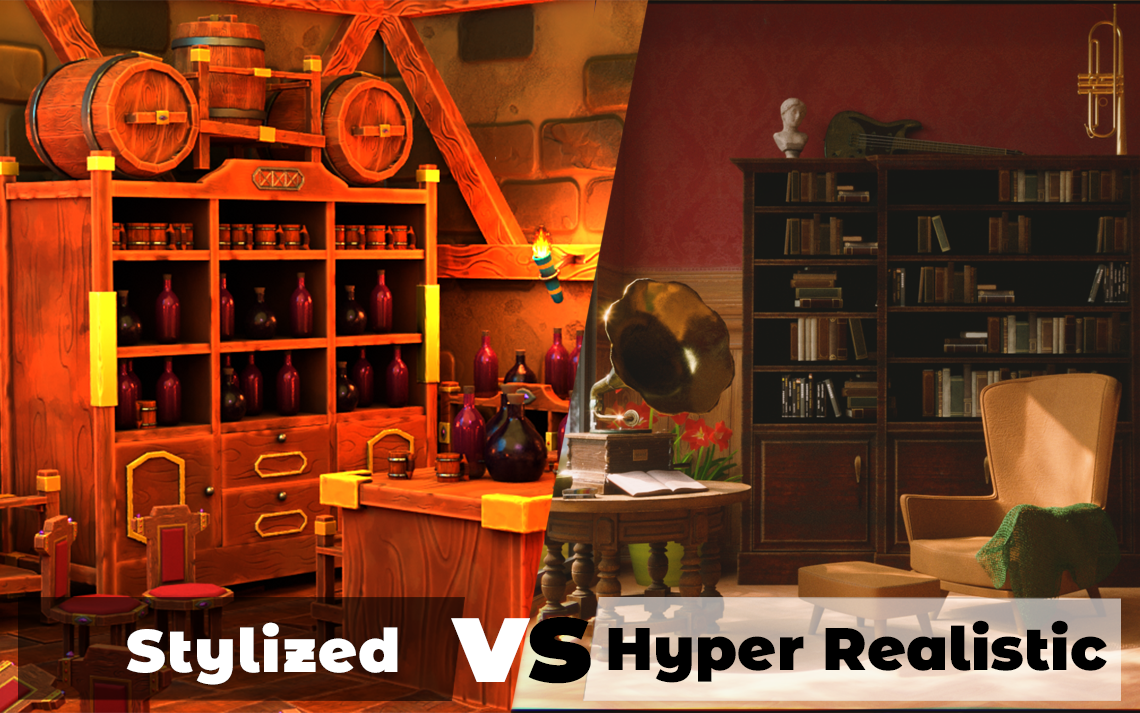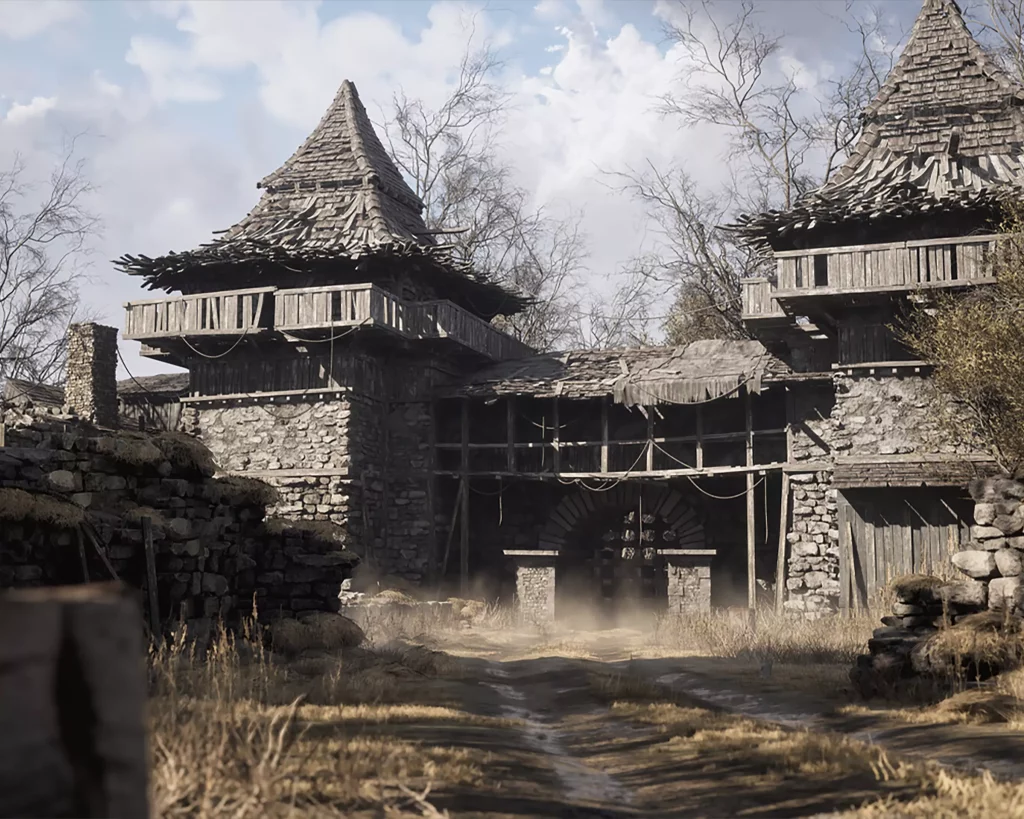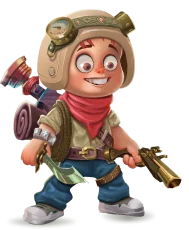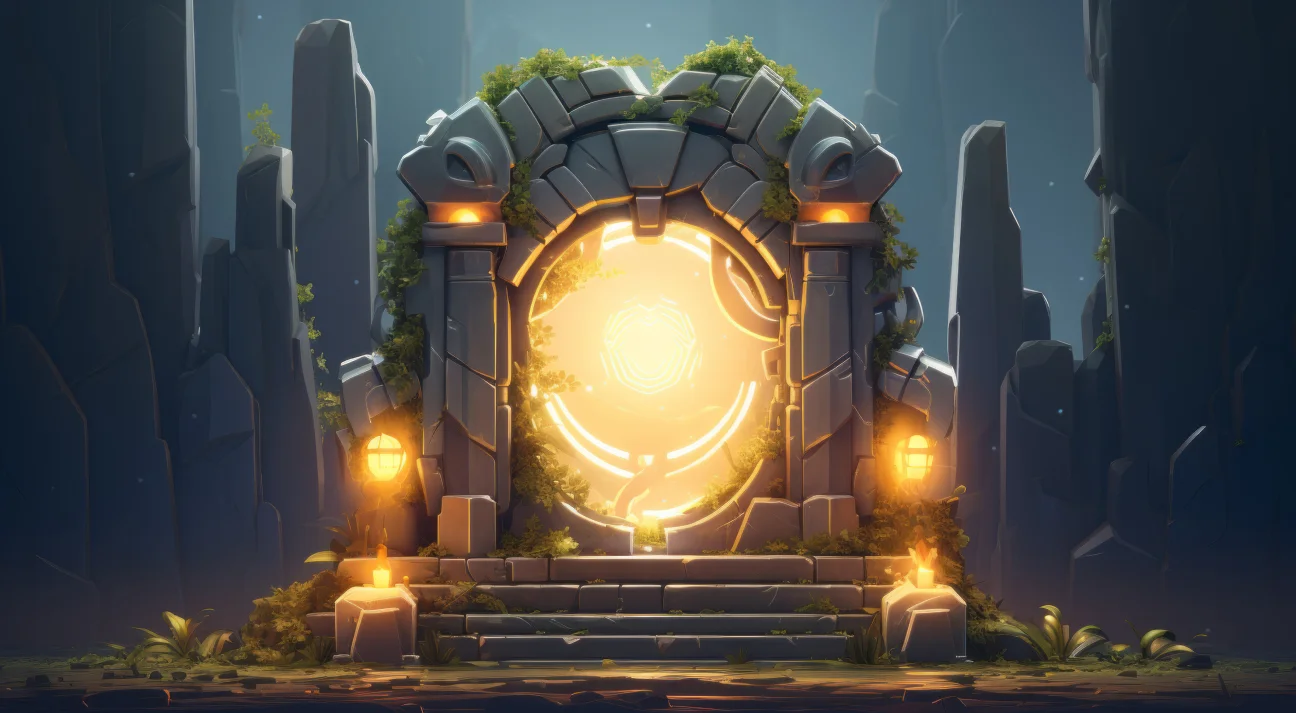
Stylized vs Hyper-Realistic: Which is Better for Game Art Design
It can be challenging to decide on the art style for your game; there are advantages and disadvantages on both sides. In this post, we’ll focus on the stylized vs. hyper-realistic game art debate.
In other words, decide if you prefer a creative or thematic style versus hyper-realistic illustrations. A whopping 26.9% of games fall in the action genre. First Person Shooters are a close second at 20.9%. Out of both these popular genres, the graphical style ( in this case hyper-real vs. Stylized) is split evenly down the middle.
Hyper-realism is self-explanatory. A great example is the development of the Call of Duty and Battlefield series. Their graphics have become more realistic over time. Visuals, assets, and elements are all improved in sharpness, simulating a real-life appearance. Faces and characters now resemble real people more.
The opposite side is more difficult. The distinctions between “stylized” games like Cuphead and The Wolf Among Us are vast. The first was carefully hand-drawn over many years and is a 2D side-scroller. It is a cartoon-like homage to the challenging old-school scrolling shooters.
Using Telltale’s exclusive game engine, the latter is a greatly stylized narrative experience that pays respect to the original comic books. Just like its inspiration, it draws players into the comic book world and keeps them there with attention-grabbing elements.
But which art style should you choose for your next game development initiative?
Read on for a thorough comparison of stylized vs. hyper-realistic art for your upcoming game.
- Stylized Game Art
- Advantages of Stylized Game Art
- Challenges of Stylised Game Art
- Hyper-Realistic Game Art
- Advantages of Hyper-Realistic Game Art
- Challenges of Hyper-Realistic Game Art
- 3 Factors to Consider While Selecting Your Game’s Art Style
- In Summation: The Battle Rages On
- What can 300Mind do for You?
- FAQs on Stylized vs Hyper-Realistic
Stylized Game Art

A stylized approach is simpler to make, at least at first glance. Delve a little deeper and the complexities begin to surface.
You need excellent artists to create strong stylized images. They must have a cohesive and creative grasp of color, design, shape, and form. Furthermore, defining an artistic style requires effort and research.
Not to mention, of course, a ton of creativity; not very pertinent when it comes to Hyperrealism, mainly because the artists have the real world as a reference.
A stylized design aesthetic also offers a considerable amount of flexibility to the designers. While stylization doesn’t mean baking in unappealing and slip-shod assets, certain imperfections add a sense of progressive art to the design.
Stylized art can be understated and minimalism is a powerful magnet capable of drawing in and retaining the playing audience. For instance, some of the most popular games right now on the App Store and Google Play Store include “Subway Surfers,” “Clash Of Clans,” “Genshin Impact,” and “Ragnarok Mobile.”
Not to add that all games with stylized art belong under the “Stylized Games” category in the Play Store and App Store. Therefore, having the game on this illustrious program can draw in additional gamers. Now that we know what stylized game art is, let’s move on to the advantages and challenges of the discipline.
Advantages of Stylized Game Art
Stylized game art offers a plethora of benefits. Here are some advantages of stylized game art:
1. Engages the Right Audience Benefits
One can learn a lot about a game’s effective tactics by researching its target audience. It’s no surprise that the majority of children’s and teen media feature cartoonish yet distinctive art styles.
Since they are accustomed to seeing styled graphics on television, the internet, and in social groups, choosing a stylized art aesthetic for a mobile game that is aimed at kids and teens will probably assist in app success.
By using a sophisticated art style that is not childish and has more solemn gameplay, you can also appeal to older audiences. For instance, “Ragnarok Mobile” includes manga-inspired objects and characters, which also fall under the heading of “Stylized graphics.”
As a result, given that many adults enjoy anime and manga, they’ll be interested in playing a game with a similar aesthetic.
In light of this, it is reasonable to believe that games with stylized graphics can appeal to a larger audience, including kids, teenagers, and young adults, as is the case with titles like Team Fortress 2 on PC and Subway Surfers. But stylized graphics can also have a lot of other advantages, particularly in terms of the gameplay experience. Let’s go deeper.
2. Benefits of Stylized Graphics for Gameplay
As discussed before, stylized games frequently provide more opportunities to showcase impressionistic settings and characters, enhancing the gameplay’s immersiveness.
However, stylized graphics can also be advantageous for important in-game information. For instance, “Team Fortress 2” was designed to feature realistic graphics, but the game developers soon discovered that doing so could make it harder to distinguish between potential collaborators and enemy graphics.
The TF2 team consequently came to the conclusion that realistic graphics wouldn’t be as beneficial for a game with classes and fast-paced combat. It’s safe to assume that they got it right based on the game’s enduring popularity after many years since its release.
3. Making It Through the Test of Time
The likelihood is high that a project will succeed in its goal of realism upon release. A previously realistic game, however, can lose its appeal within a few years, when most games offer higher levels of detail and reality-centered objects and textures. This is because realism-rich graphics in video games are always evolving.
On the other hand, games with stylized graphics tend to continue longer since they aren’t truly competing in terms of realism. For instance, PC games like Morrowind and Oblivion are starting to seem a little stale.
The popular Wind Waker game for the Nintendo GameCube continues to look fantastic. In conclusion, strong distinctive art will still look good after ten years, however realistic graphics may begin to look dated after some time.
4. Making a Visual Statement
A little more polish can be added to your game using stylized graphics. Naturally, a lot will depend on the genre. Take the overuse of realistic graphics in first-person shooter games, for instance.
FPS games frequently strive for realism, making the genre oversaturated. See how the popular game series Borderlands uses toon graphics to somewhat alter the FPS genre. Additionally, other recently launched PC games, including Overwatch and Valorant, have stylized graphics as well, which has proven to be incredibly profitable given both games’ current success.
The same strategy applied to an FPS on mobile has the potential to be equally beneficial. In genres where realism is overused, cartoon or stylized graphics help your game stand out.
5. Compatibility with Legacy Technologies
Games with realistic graphics would therefore need a specific technology, most likely one that is modern. You won’t get the best results if you attempt to attain realism by employing outdated technology.
As a result, you are now dependent on new technologies, which will also have an impact on game updates in the future. Styled graphics don’t necessarily require modern technology; they work well on the majority of software and hardware with less effort. You won’t necessarily need to rely on cutting-edge technologies if you use stylized graphics.
6. Catchy Artistic Lighting
Game artists are often forced to adhere to the lighting and color standards of real life when creating graphics with a focus on realism. Of course, when done right, this can provide amazing results. Mobile devices might have a little trouble recreating this, though. However, styled graphics give the opportunity to benefit from good lighting combined with artistic flair.
Thus, without having to worry about it deviating from realism, this allows artists to improve and manage the lighting as they see fit.
For instance, it’s perfectly fine in games with stylized graphics to make the ambiance in-game appear as though it’s been put through “filters.” As seen in the PC game Kynseed, fascinating lighting effects are frequently used in pixelized games.
7. 2D Design is Quicker and Allows for Experimentation
Although this isn’t a hard and fast rule, in most cases, stylized design is quicker. A stylized item often takes less time to create and combine textures since it typically has more pronounced shapes and less surface information. For example, orange skin is very porous, wrinkled, and organic, making it difficult to replicate and sculpt.
On the other side, when a stylized design approach is followed, pores are more likely to be larger, wrinkles to be more obvious, and organic aspects to be less minimal in stylized graphics.
Since stylistic assets typically take an exaggerated course, they will probably be simpler to sculpt and texturize because they will display more obvious shapes.
Challenges of Stylised Game Art
At first glance, stylized game art may seem easier to create, however, this is quite far from the truth. Here are some challenges:
1. Stylization Struggles against Hyper-Realism in Terms of Popularity
A significantly smaller subset of the global gamer user base prefers stylization versus hyper-realistic games. This is because stylized games are generally considered to be more child-friendly and immature. This is unequivocally untrue but once a perception builds it becomes very difficult to alter mass beliefs.
2. Extra Effort is Required to keep the Stylization Cohesive
Stylized art has a smaller target audience and this can shrink even more if the art style isn’t cohesive throughout the game. A lack of aesthetic direction can significantly impact appeal and subsequently sales. As mentioned earlier, stylized games are generally perceived as ‘inferior’ to games that are hyper-realistic.
Hyper-Realistic Game Art

At first glance, one might assume that achieving hyper-realism would be very challenging. Attempting to replicate a real-life appearance must be more challenging than an artist’s interpretation of a certain style or theme.
Realistic game art and models are now more available than ever because of the games industry’s rising reliance on technology. Although it is pricey, the tools are already in place to scan an actor’s entire body and create a high-quality 3D model. Things that were once only dreamed of by game artists and designers suddenly look truly doable with the release of next-gen game engines.
Technically speaking, establishing a hyper-real baseline is simpler. Refining is difficult and time-consuming. Errors are readily apparent with such intricate and realistic representations. The animation must be flawless; if it is hyper-realistic, players will immediately notice a poor run-cycle. In this situation, the devil is in the details.
However, it’s crucial to keep in mind that these particulars require a lot of resources. Both in terms of technology and human resources. And because these expenses are frequently significant, larger studios are typically those who strive for hyper-realism.
Advantages of Hyper-Realistic Game Art
Here, we examine the significance of realism in video games and question whether it is actually necessary for us to have a positive and fulfilling experience.
1. Immersive Visuals
The caliber of the graphics and the art direction the developers follow are two of the most significant elements that are consistent throughout video game genres. These play a critical role in what distinguishes the game from the competition and form the user’s perception of the game.
2. Enhanced Levels of Interactivity
Consider what occurs when a game’s goals change and the art style changes in a similar universe, like that of The Walking Dead. For instance, the developers of Payday 2, recently revealed a co-op first-person shooter set in the world of The Walking Dead.
Being a shooter is one thing, and it is probable that they are aiming for a more realistic experience with the added RPG elements of the game. To experience the grime and misery of the world in a fresh way, hyper-realism is a must-have.
Their art style aims to depict the gore and atrocities of a post-apocalyptic world, while Telltale’s draws you into the emotional component of the story. For these games to accurately convey the experience they want the user to have, hyper-realistic art styles are required.
3. A “Connect” with the Character
In terms of producing characters that seem authentic and true to life while also having at least a plausible backstory, story and characters are where realism should be applied consistently throughout games.
The player won’t enjoy the game as much overall if there aren’t accurate representations of individuals in it.
Consider some of the best authors of our time, such as Stephen King, who didn’t set out to write huge, expansive works of literature but are skilled at telling a compelling tale. Forgive the pun, but his portrayal of children, particularly Danny Torrance in The Great, is a shining example of what realism can do. Because of how realistically he writes about people, the supernatural elements are exceptionally believable and visceral.
The same is true of video games, while there are some outlandish circumstances that, when executed effectively and you relate to the characters, make you believe the plot. The Last of Us is the ideal illustration of a scenario that has never occurred in our world, but the writing of the story and the characters makes you believe it.
Even though it doesn’t seem particularly possible, you are drawn in and feel a connection to the story. Joel’s actions at the end of the game, losing friends like Tess, and the bond between Ellie and Joel develop slowly; these elements give the game a gritty, real-world feel that propels it onward.
4. Realism helps further the Plot
When it comes to the plot and characters in video games, realism is unquestionably a major factor. For you to believe the story you are being told, visual art matters a lot.
Though it is crucial to incorporate realism into the plot, it should not be present in every aspect. Without it, you would aimlessly switch between games without ever experiencing the thrills and heartbreaks that gamers have come to know and love when playing a game.
Challenges of Hyper-Realistic Game Art
Although there are other elements that help a game succeed, this does not mean that realism should be completely ignored. Here are some challenges of hyper-realistic art:
1. Larger Download Size
Hyper-realistic games have a larger download size. This becomes a major issue when it comes to games for mobile platforms.
A large installation file might dissuade customers from downloading the game leading to a loss of users. Furthermore, larger games take up more space on the limited storage that mobile devices sport, resulting in a larger number of uninstalls.
2. Increased production Time
Given the amount of work required to make a game as life-like as possible, the production time of a hyper-realistic game is a lot more than its stylized counterpart.
From lighting to animation and rigging and on to asset creation, every facet of game design needs to focus on the finer nuances of realism where even a single misstep could spell doom for a hyper-realistic game.
3. Increased Art Budget
The art budget of a hyper-realistic game is a lot more than that of a stylized game. Game artists need vetted expertise in the art form. Lighters and technical artists have to put in extra work to bring the game art to hyper-realistic levels.
Moreover, it is much harder to cover up errors while working on a hyper-realistic game. A single botched animation or an in-game asset that looks even slightly cartoonish could prove to be a massive snag when it comes to game art design.
3 Factors to Consider While Selecting Your Game’s Art Style
There is consensus among the game development industry on three major factors to take into account when choosing your art style. The factors are as follows:
1. Budget
Hyper-realism frequently requires more money and resources. Because of this, we frequently notice larger studios utilizing this art form. Many studios, including Naughty Dog, have found success with hyper-realism. The Uncharted series and the GTA titles are renowned for their advancements in achieving photorealism.
2. Market
Both hyperrealism and stylization require a market and an audience to be successful. Your team must comprehend your target audience and how to interact with them most effectively. Because you are a larger studio, you are not required to attempt hyper-realism; if your audience like your stylized games, go for it!
3. The Effect of Management
In comparison to the other two points mentioned above, this could sound weird. But the art selections can be affected by your creative director, CEO, or owner. In the end, your creation serves a purpose.
The stylized comic-book aesthetic in The Wolf Among Us was forced from the top down. There was a clear intention to directly imitate the original in order to honor it. The design team and those in charge must take their desires into account. Games are labors of love; to create the best ones, one must be passionate about what they are doing.
Real also: How to Choose The Right Type Of 3D Game Art Style?
In Summation: The Battle Rages On
It is challenging to find a soft spot for your project because every style of video game art often has pros and cons in terms of gameplay, technology, and aesthetics. The general rule is to keep in mind that the game’s aesthetics should express the essential elements of the gameplay while also being realistic about the team’s experience and the available budget.
Additionally, it’s critical to be conscious that the game’s art has a significant impact on immersion and user appeal. As a result, don’t choose the graphic design of the title before proper research.
The best course of action is to choose the gameplay first, then think about the graphics. You can begin investigating the art style that will enable the game to exhibit its features more effectively after generating an early prototype and playing it sufficiently to get the playtest data.
What can 300Mind do for You?
Offering a user base of thousands worldwide and years of experience on all key platforms, such as iOS, Android, Web, and PC, among others, top-tier businesses from all around the world depend on us as reliable partners. Interested? Drop us a line and let’s discuss your game development vision. Until then… Game on!
FAQs on Stylized vs Hyper-Realistic
The best course of action is to choose the gameplay first, then think about the graphics. You can begin investigating the art style that will enable the game to exhibit its features more effectively after generating an early prototype and playing it sufficiently to get the playtest data.
Good game design is cohesive; when combined with other elements of the design and the game itself, it creates a complete experience for the player. It’s not enough for an idea to be good on paper; it also needs to be good in the actual game. Strong game design has good implementation.
Stylized art is not always harder than realistic art. Laymen who prefer more detailed works of art tend to put forth the argument that photorealism is directly correlated to skill, but there is plenty of variation. Very often keeping in line with complex style guides for stylized art can prove quite difficult.
The significant difference between realism and stylized is that with realism you are restricted to making things look ‘real’ while enhancing their visual language. With stylized you are free to play with the shapes, colors, exaggerate or remove details to enhance the look and feel.








